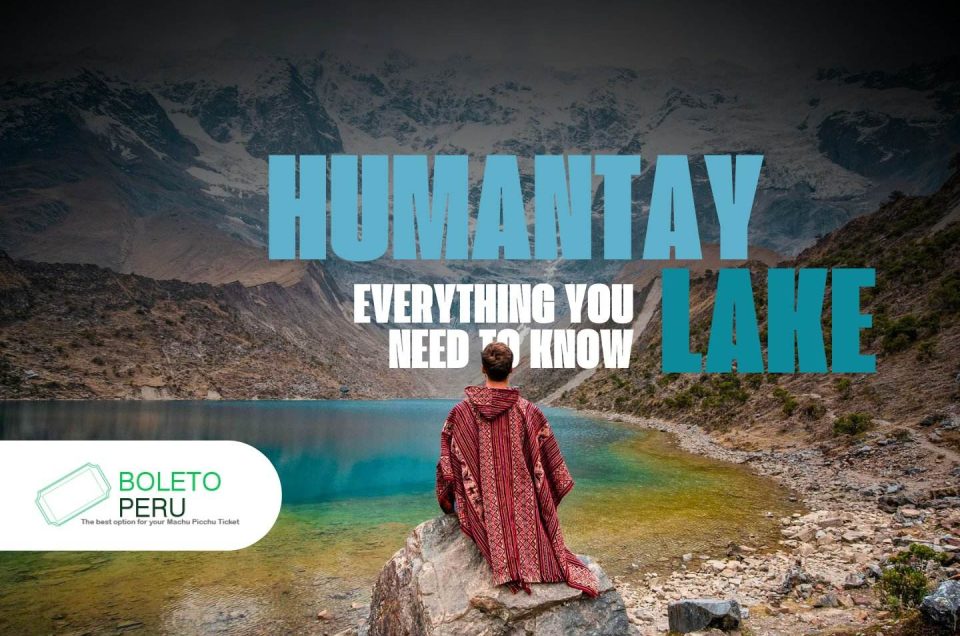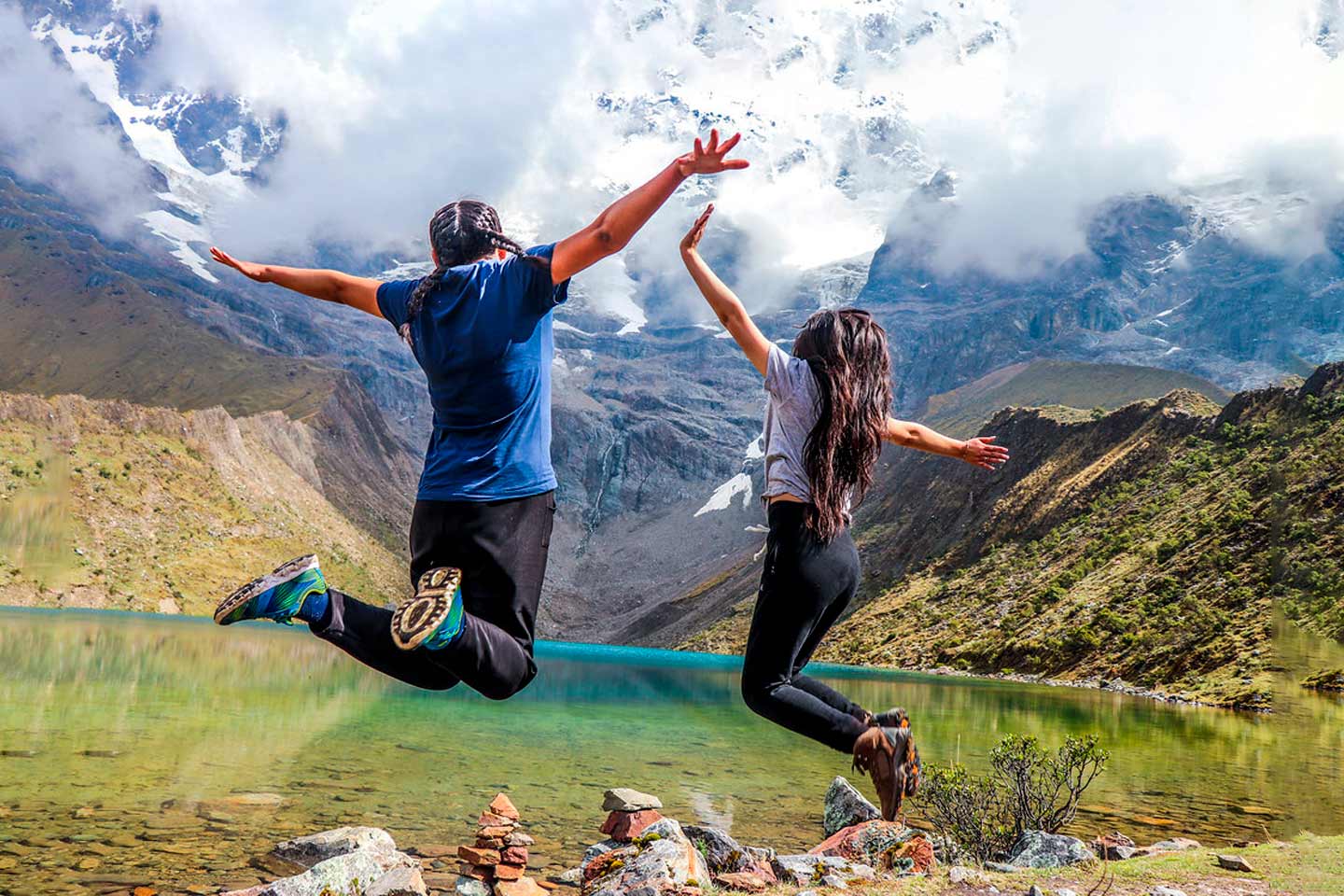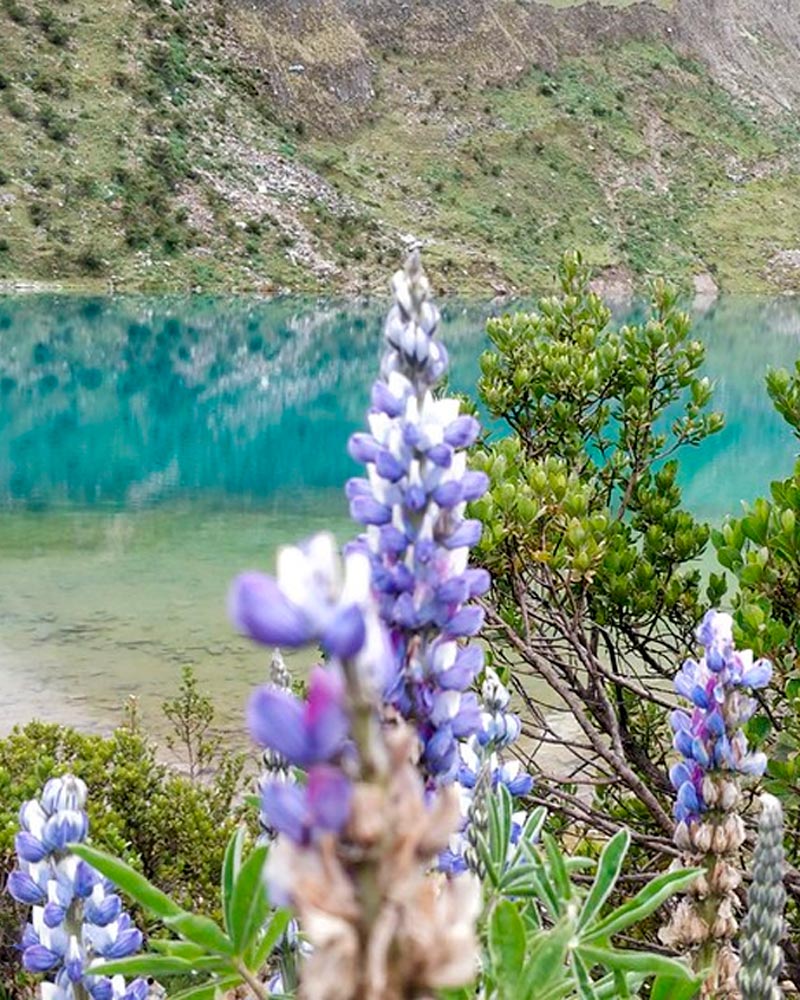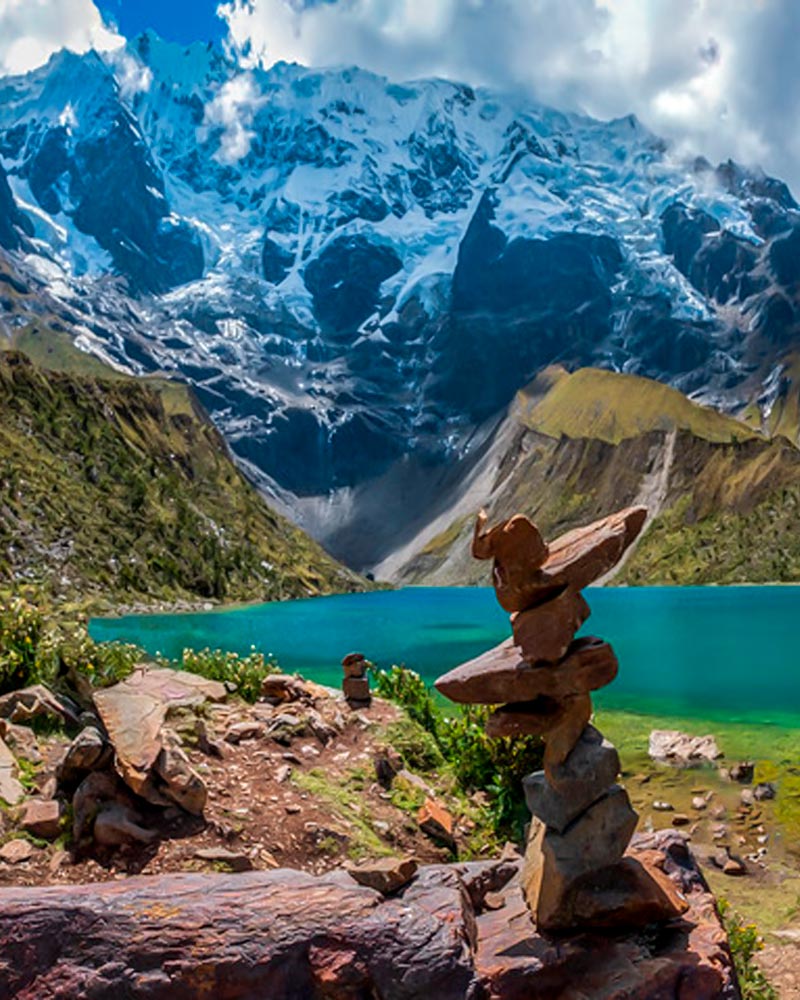Humantay Lagoon, with a deep turquoise color, is surrounded by tall snowy peaks of the Peruvian Andes. It has become a symbol of Cusco’s natural beauty. Located over 4,200 meters above sea level, this icy jewel shines with its color and the clear reflection of the nearby peaks, offering a visual show that makes you fall in love from the first moment.
Its fame has grown because it is both beautiful and easy to reach: in one day, visitors can leave the imperial city of Cusco, walk up Andean paths, and get to the lagoon to see one of the most photographed places in the region. Also, being close to the Salkantay Trek, the second most popular path to Machu Picchu, has made it even more appealing, as it is a must-see stop in the Cusco region.
About Humantay Lagoon
Humantay Lagoon Peru is a glacial lake formed by melting snow from Humantay mountain, one of the smaller peaks of Salkantay mountain in the Cusco region. Also, its waters, clean and full of minerals, get a turquoise color that changes with the sunlight and the time of year.
Humantay’s popularity has grown a lot in the last ten years, mostly because it’s easy to get to: the trip can be done in a one-day tour from Cusco, without needing to stay overnight on the path. This makes it great for those who don’t have much time but want to see high mountain views. Also, its amazing color and mountain setting have made the lagoon one of the most photographed places in the region, appearing on social media, travel blogs, and in tour guides’ plans.
Another key reason for its fame is its cultural link: many visitors use their time there to honor Pachamama (Mother Earth) with traditional offerings on its shores.
Meaning and Origin
The word “Humantay” is understood in different ways based on local traditions and studies of Quechua. One common way to read it connects its root “Huma” with “head” (or something “main” or “important”), while the ending “-ntay” seems to show belonging or relation. Because of this, many translate “Humantay” as “sacred head” or “head of the gods,” highlighting the spiritual value this place has had for Andean communities over the centuries.
As for how it was formed, Humantay Lake is in a glacial basin made during the Pleistocene period. The melting of old glaciers shaped the hills and flat areas from which the melting snow of Humantay mountain now flows, bringing minerals that give its waters a turquoise color.
Historically, even though no signs of big Inca buildings are found on its shores, the lagoon was part of the holy landscape tied to the worship of the “apu” (mountain spirit) and Pachamama. But, small offerings have been found nearby, which suggests that Humantay was a place for pilgrimages and ceremonies to give thanks to water and the universe in Inca culture.
Geographic Location
The Lagoon is located on the west side of the Vilcabamba Mountain Range, inside the Limatambo district (Anta province), in the Cusco region, Peru. Also, it is located about 4 200 meters above sea level. In this Andean highland area, known for grasslands, wetlands, and puyas, it creates a wild landscape, great for looking at the high mountains.
Its connection with the Salkantay mountain, which at 6 271 m is Cusco’s second highest peak, is very close: Humantay is one of the glacier water sources of that main mountain mass. From the edge of the lagoon, looking south, you can see the grand snowy shape of Salkantay, whose peaks feed the constant flow of water that keeps this turquoise mirror alive in the heart of the Andes.
How to Get to Humantay Lagoon
Before we explain each part of the trip, it’s important to say that the journey to Humantay Lagoon mixes road travel and a high mountain hike. Because of the high altitude (more than 3 800 m in Soraypampa and 4 200 m at the lagoon), it’s a good idea to spend at least one day in Cusco to get used to it and avoid altitude sickness. The full trip from the imperial city can be done in one day, though many travelers choose to book an organized tour that handles the travel, guide, and permits. Here are the steps and choices you can make to get to this place:
Step 1: From Cusco to Soraypampa
- Distance and time: About 60 km of road (2–3 h), mostly on winding roads that go through mountains.
- Starting point: Most tours leave before sunrise from the center of Cusco, but you can also get private transport.
- Stops along the way: There’s usually a short stop in Mollepata or Limatambo for breakfast and to get supplies. The road goes up slowly to the start of the trail in the small village of Soraypampa (3 900 m).
Step 2: Hike from Soraypampa to the Lagoon
- Distance and time: About 6 km round trip, with a height change of about 300 m; it takes between 1 h and 1 h 30 min to go up, and 45 min to go down.
- Trail: Well marked, with parts of loose stones and medium slopes, going through fields of puyas and with views of Salkantay.
- Tips: Bring hiking poles to help you stay steady on the steeper parts and make frequent stops to control your breathing and speed.
Tour and Transport Choices
- Organized tours: These include round-trip transport from Cusco, a guide who speaks two languages, snacks, hiking poles, and, in many cases, a typical lunch. This is the easiest choice for those who prefer a ready-made plan.
- Private or group transport: For those who travel on their own more, you can rent a 4×4 vehicle or go by group transport to Soraypampa; from there, you hike on your own.
- Permits and rules: Entry to the lagoon needs a payment at Soraypampa (usually collected by the local community), and this money helps with keeping the trails and basic services in good shape.
Natural Features of the Lagoon
- Color of its waters: The special turquoise color of Humantay Lagoon comes from the high amount of dissolved minerals brought by the melting snow. Small bits of mica and calcium carbonate in the water make the sunlight bend, showing off the green-blue color. This changes during the day (stronger with full sun and softer in the early morning or at sunset) and also depends on the time of year, when how much snow melts and how cloudy it is changes.
- Plants and animals nearby: The nature around Humantay is like a high mountain grassland. Among the plants, you can see ichu grass, a type of grass field that can handle frost, and puyas (Puya raimondii) spread out on the lower slopes. For animals, you can spot vizcachas (Lagidium peruanum) among the rocks, and various high-flying birds like the mountain sparrow and sometimes Andean condors, whose grand shapes fly over the icy valley.
- Panoramic view of Humantay mountain: When you get to the edge, the lake offers a clear, straight view of the Humantay snowy mountain, whose rocky, snow-covered top sits on the horizon. The mix of colors (the white of the mountain, the gray of the rocks, and the turquoise of the water) creates a landscape of strong differences. This is not just a nice view, but also helps you see how the ice moves and the living geology of the Andes.
|
|
|
|
Climate and Temperature
Humantay Lagoon is in a high Andean mountain area, where the weather goes from cold to mild, with clear differences between day and night.
Seasons of the year
- Dry season (May – September): Clear skies and very little rain, great for walking. The highest daily temperatures are usually around 8 °C – 12 °C, while the lowest night temperatures can drop to −5 °C or even close to −10 °C in the coldest mornings.
- Rainy season (October – April): More clouds and frequent rain, especially in the afternoons. The highest temperatures drop a bit (6 °C – 10 °C) and nights are still freezing (−2 °C – −7 °C), making paths more likely to be slippery.
Daily changes
- Morning: Very cold at sunrise; it’s common to find frost on the ichu grasslands.
- Midday: Quick rise in temperature with full sun; pleasant temperatures of 8 °C – 12 °C are felt in the sun.
- Afternoon and sunset: Quick drop in temperature as the sun sets, plus high-altitude wind.
- Night: Very cold, feeling colder than −5 °C.
At any time of year, it is very important to wear many layers of clothes and sun protection, as the UV radiation is very strong at over 4,000 m above sea level.
Difficulty of the Walk
The path to Humantay Lagoon, though quite short (about 6 km round trip), has a very steep last part and the added challenge of the high place. This makes it a medium difficulty for walkers with little experience at high altitudes. Below are the key points of its difficulty level:
Level of physical challenge
- Distance and elevation change: About 300 m of climbing in just 2 km from Soraypampa to the lagoon.
- Type of ground: Compact dirt paths with parts of loose stones and meltwater channels that can make walking steady hard.
- Approximate time: 1.5 – 2 hours up and 1 – 1.5 hours down, depending on your speed and stops for getting used to the altitude or taking pictures.
- Tip: Keep a steady pace and take frequent breaks; using poles can lessen stress on knees and ankles.
Things to think about due to altitude
- Altitude sickness: At over 4,000 m, it’s common to feel headaches, nausea, or tiredness.
- Getting used to it first: Spending at least 1–2 days in Cusco (3,400 m) doing light activities helps to lessen the effects.
- Hydration and food: Drink lots of water and eat foods rich in carbohydrates before and during the walk.
- Warning signs: Strong dizziness, throwing up, or very hard breathing mean you need to stop and even go down right away if you don’t get better.
Activities You Can Do
- Hiking
The main thing about Humantay is, without a doubt, the walk to its edges. The path goes through grass fields, with constant views of the Salkantay mountain. Along the way, you will find natural viewpoints where you can stop to enjoy the living geology of the mountain range and the wild animals that live at these heights. The final climb, with a steep slope, rewards you with the amazing view of the turquoise lake.
Note: This route is also part of the famous Salkantay Trek to Machu Picchu, fitting in as one of the most amazing parts of that journey. - Landscape Photography
Thanks to the contrast of its water color with the white of the glaciers and the gray of the rocks, Humantay is a paradise for landscape photographers. It’s good to bring a wide-angle lens to capture how big the valley is and a polarizing filter to make the water color stronger and reduce reflections. Sunrise and sunset offer the best shots, as they make the textures and shadows stand out, while a clear sky allows for sharp pictures with the snowy mountain in the background. - Andean Rituals (Offerings to Pachamama)
When reaching the lagoon, many visitors do small ceremonies to thank Pachamama. These offerings usually include coca leaves, flowers, and corn kernels, carefully placed on flat rocks near the shore. This symbolic act honors the old tradition of asking the Earth for permission and thanking it for its kindness.
What to Bring if You Take a Tour to the Lagoon?
Getting ready properly will make the difference between a nice trip and an uncomfortable challenge. Keep in mind that conditions can change quickly: the sun is strong during the day and the cold bites in the late afternoon. So, it’s very important to plan ahead for the gear and supplies that will make sure you are comfortable, safe, and fully enjoy this high-altitude place.
Recommended Clothes and Shoes
- Warm layers: Shirt and pants made of special materials that pull sweat away (first layer), followed by a fleece jacket or light sweatshirt (second layer), and a waterproof and windproof jacket (third layer).
- Trekking pants: Comfortable, strong, and allowing free movement; best with side zippers for air.
- Shoes: High and waterproof hiking boots, with good grip and ankle support. Special socks that stop blisters and keep feet dry.
- Accessories: Hat or neck gaiter for morning warmth and evening cold, light gloves, sunglasses with UV protection, and a hat or cap for midday.
Essential Items
- Water: At least 1.5 L per person; high altitude increases dehydration.
- Sunscreen: UV radiation is very strong at high altitude.
- Energy snacks: Dried fruits, cereal bars, chocolate, or dried fruits to keep your sugar level up.
- Trekking poles (optional): Help reduce knee tiredness and keep balance on uneven parts.
- Day backpack: Light, waterproof, with enough space (20–30 L) to carry all the above.
Tips for a Comfortable and Safe Experience
- Get used to the altitude first: Spend at least 24 hours in Cusco before the walk to get used to the high place.
- Steady pace: Avoid starting fast; breathe deeply and keep a comfortable speed.
- Check the weather: Look at the forecast the evening before and adjust your gear (waterproof layer, thicker gloves) as needed.
- Respect the surroundings: Follow the marked paths, do not throw trash, and keep ceremonial offerings in special areas.
- Local guide: Choose a tour with certified guides; they know the route, animals, plants well, and can help with any problem.






